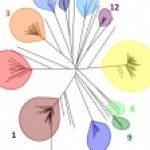Lien vers Pubmed [PMID] – 18057125
J. Clin. Microbiol. 2008 Feb;46(2):652-64
The pathogenic yeast Candida dubliniensis is phylogenetically very closely related to Candida albicans, and both species share many phenotypic and genetic characteristics. DNA fingerprinting using the species-specific probe Cd25 and sequence analysis of the internal transcribed spacer (ITS) region of the ribosomal gene cluster previously showed that C. dubliniensis is comprised of three major clades comprising four distinct ITS genotypes. Multilocus sequence typing (MLST) has been shown to be very useful for investigating the epidemiology and population biology of C. albicans and has identified many distinct major and minor clades. In the present study, we used MLST to investigate the population structure of C. dubliniensis for the first time. Combinations of 10 loci previously tested for MLST analysis of C. albicans were assessed for their discriminatory ability with 50 epidemiologically unrelated C. dubliniensis isolates from diverse geographic locations, including representative isolates from the previously identified three Cd25-defined major clades and the four ITS genotypes. Dendrograms created by using the unweighted pair group method with arithmetic averages that were generated using the data from all 10 loci revealed a population structure which supports that previously suggested by DNA fingerprinting and ITS genotyping. The MLST data revealed significantly less divergence within the C. dubliniensis population examined than within the C. albicans population. These findings show that MLST can be used as an informative alternative strategy for investigating the population structure of C. dubliniensis. On the basis of the highest number of genotypes per variable base, we recommend the following eight loci for MLST analysis of C. dubliniensis: CdAAT1b, CdACC1, CdADP1, CdMPIb, CdRPN2, CdSYA1, exCdVPS13, and exCdZWF1b, where “Cd” indicates C. dubliniensis and “ex” indicates extended sequence.



